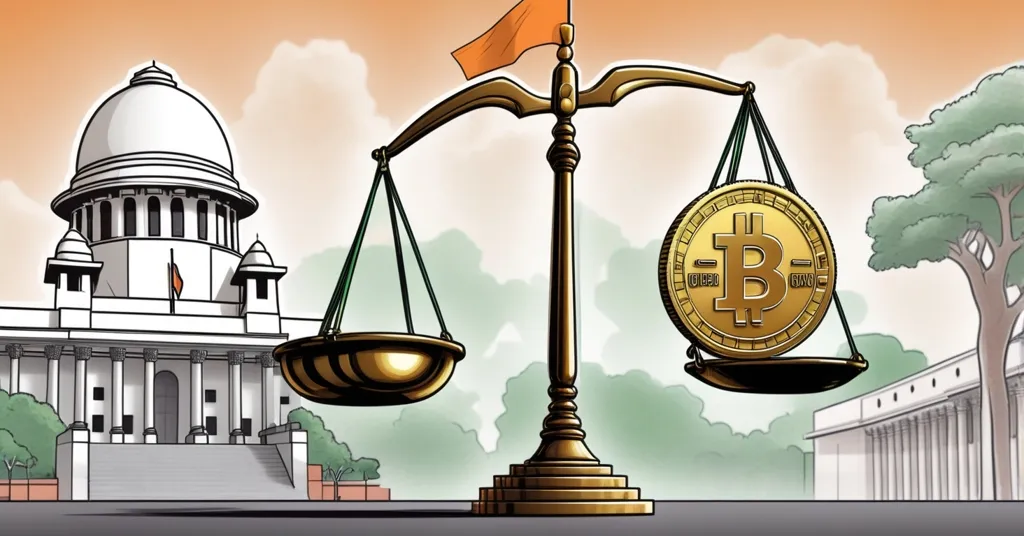Supreme Court of India Warns of Crypto’s Parallel Economy Threat

Cryptocurrencies Threaten National Stability, Indians Doubt
The Supreme Court of India has raised alarms over the unchecked growth of cryptocurrencies, warning of a “parallel economy” that could undermine national stability. In a recent hearing linked to a high-profile Bitcoin fraud case, the court lambasted the government’s 30% crypto tax without a regulatory framework.
- Supreme Court warns of ‘parallel economy’ risk
- 30% crypto tax criticized without regulation
- India lags in crypto regulation; RBI pushes Digital Rupee
The court’s stern comments come in the wake of a case against Shailesh Bhatt, accused of running one of the largest Bitcoin fraud rings in Gujarat. Justice Surya Kant questioned the government’s contradictory stance, stating, “You are taxing crypto at 30%, but there is no regulatory framework. How can something be taxed but not run?” This case exemplifies the growing tension between the rapid adoption of cryptocurrencies and the government’s hesitation to establish clear rules.
India’s current approach to crypto taxation is harsh, imposing a flat 30% tax on capital gains from crypto trades, a 1% TDS on every transaction, and prohibiting the offsetting of losses. This has pushed crypto activities into a legally ambiguous gray zone, ripe for exploitation by fraudsters. The Financial Intelligence Unit (FIU) has attempted to curb this by mandating crypto exchanges to comply with the Prevention of Money Laundering Act.
Despite these efforts, India remains without a comprehensive crypto bill. A draft legislation from 2021 has yet to reach Parliament, leaving a policy void that exacerbates the risks the Supreme Court highlighted. Justice N Kotiswar Singh’s comparison of unregulated crypto activity to “hawala trading — a black box economy” paints a vivid picture of the current situation. In simple terms, hawala is an informal method of transferring money without any physical movement, often used to skirt around formal financial systems.
On the global stage, the regulatory landscape is evolving. Europe took a significant step with the 2023 approval of the MiCA law, setting stringent requirements for crypto platforms. The U.S. is also actively working on crypto legislation through SEC enforcement and congressional bills. Meanwhile, India’s central bank, the Reserve Bank of India (RBI), continues to warn against the dangers of private cryptocurrencies, instead promoting its own digital currency, the Digital Rupee.
The RBI’s push for the Digital Rupee, a Central Bank Digital Currency (CBDC), reflects a broader debate about the role of government-controlled versus private digital currencies. Despite aggressive piloting since December 2022, the Digital Rupee’s usage remains low, at about 0.006% of total banknotes in circulation as of late 2024. This suggests a lack of significant demand, perhaps because India’s Unified Payments Interface (UPI) already dominates digital transactions.
India’s current wait-and-watch approach carries significant risks. Experts warn that stringent tax policies and regulatory delays could drive crypto traders underground or offshore, making oversight even more challenging. Meanwhile, the internationalization of the Digital Rupee remains uncertain, with no partnerships yet established for cross-border payments.
The global acceptance of cryptocurrencies, such as buying cars with Bitcoin in Europe, contrasts sharply with India’s cautious stance. Lawyer Mahesh Jethmalani noted, “People across the world are using Bitcoin — even buying cars in Europe with one coin.” This demonstrates the potential for cryptocurrencies to drive financial innovation and inclusion, if managed correctly.
As the debate continues, the Supreme Court’s intervention may push the government towards more decisive action. Additional Solicitor General Aishwarya Bhatti has indicated she will seek more information from policymakers, signaling potential movement towards a more defined regulatory framework.
India’s crypto regulation is like a slow train on a fast track—everyone’s waiting to see when it will arrive. The question remains: Can India harness the transformative power of cryptocurrencies while safeguarding its economic stability?
Key Takeaways and Questions
- What concerns does the Supreme Court of India have about cryptocurrencies?
The Supreme Court is concerned that unregulated cryptocurrencies are forming a “parallel economy” that poses a significant risk to national stability.
- Why did the Supreme Court criticize the Indian government’s approach to cryptocurrencies?
The court criticized the government for taxing cryptocurrencies at 30% without providing a regulatory framework, highlighting the contradiction and legal ambiguity.
- What is the current state of cryptocurrency regulation in India?
India lacks a central crypto bill, and while a draft legislation has been in existence since 2021, it has yet to reach Parliament, leaving a policy vacuum.
- How does India’s approach to crypto regulation compare globally?
India is lagging behind countries like Europe, which has approved the MiCA law, and the U.S., which is working on crypto legislation, in terms of regulatory action.
- What alternative to private cryptocurrencies is the Reserve Bank of India promoting?
The RBI is promoting the Digital Rupee, a central bank digital currency (CBDC), as a safer, government-backed option.
- What are the potential risks of India’s current wait-and-watch approach to cryptocurrencies?
Experts argue that this approach may leave India exposed to systemic risks, particularly with increasing crypto activity shifting to peer-to-peer and offshore platforms.
- How could decentralized technologies benefit India if regulated properly?
If regulated effectively, cryptocurrencies could enhance financial inclusion, foster innovation, and provide an alternative to traditional banking, potentially driving economic growth.



